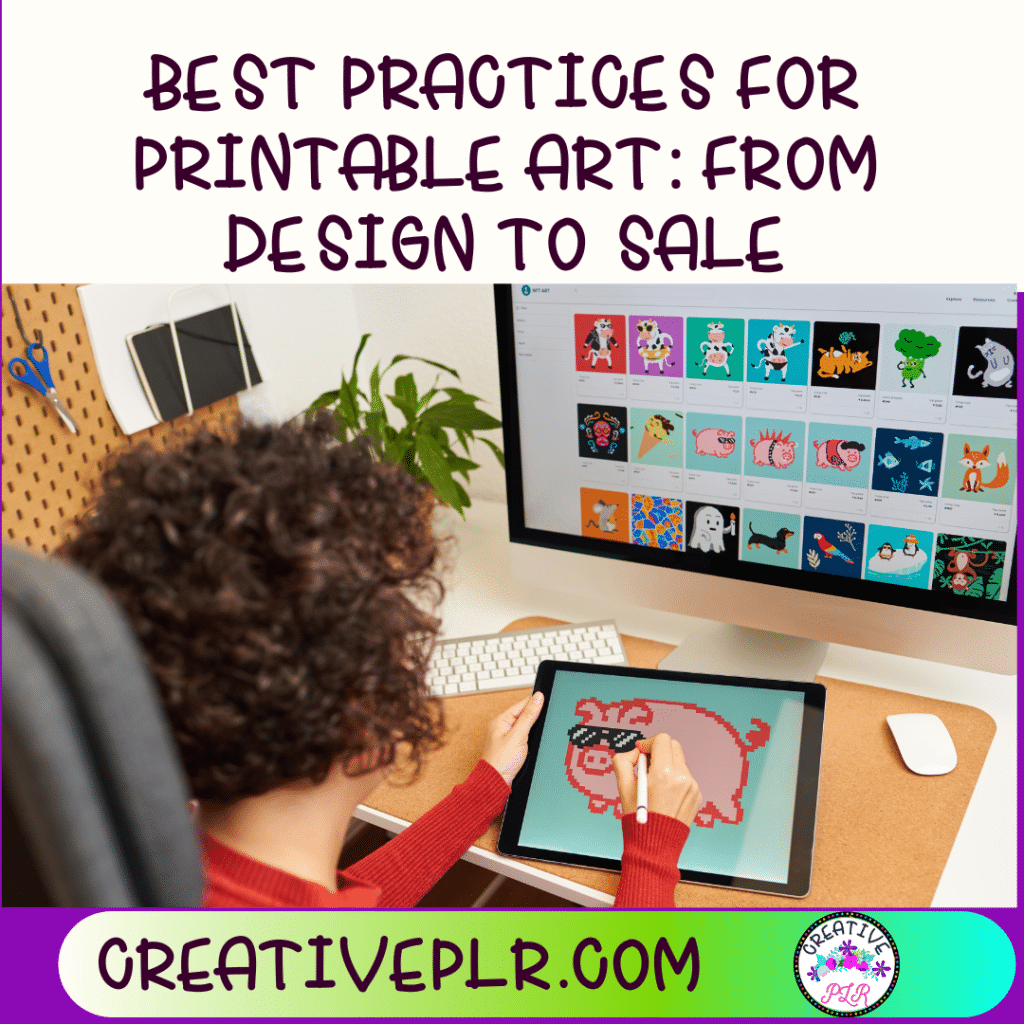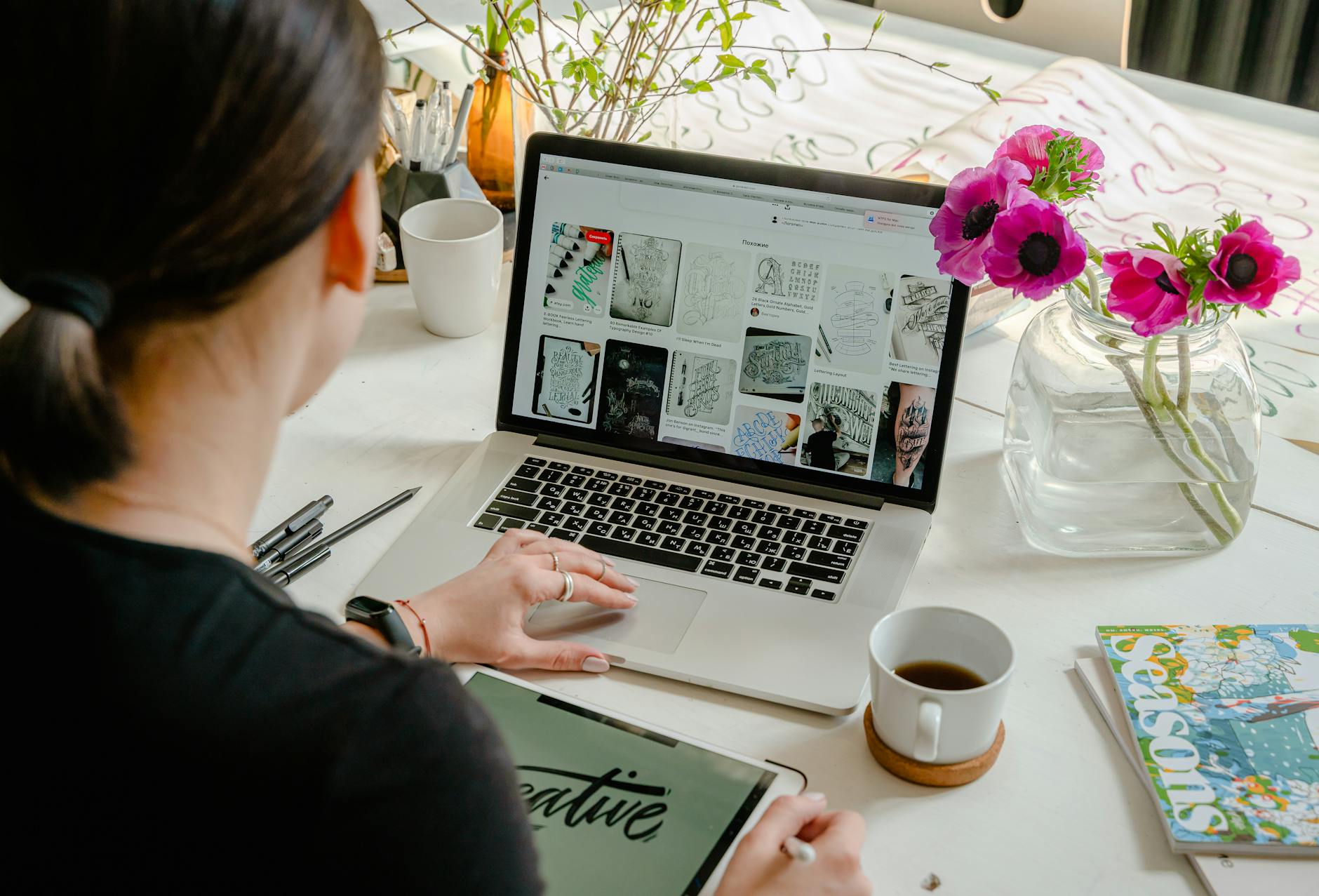Printable art is skyrocketing in popularity. It’s an exciting avenue for artists and entrepreneurs. It provides a profitable way to share creativity with the world. Are you an artist wanting to expand? Or are you a newbie exploring digital sales? You need to understand the best practices for designing and selling printable art.

Ready to turn your creativity into cash? Here are some tips for creating art that you can sell. Not an artist? Neither am I but I have sold graphics, wall art, digital products, and all types of artistic printables. You can use tools to create designs that others will enjoy.
Designing Printable Art
Creating printable art requires a mix of creativity and technical know-how. This section will guide you through the key steps and tips. They are for designing great printable art that will captivate your audience.
Design Principles and Techniques
When designing printable art, it’s crucial to understand and apply fundamental design principles. Here are some key aspects you should consider:
Color Theory: Colors can evoke emotions and set the tone for your artwork. Understanding color theory helps you create pieces that are visually appealing. For example:
- Use complementary colors to create balance.
- Utilize analogous colors for a harmonious look.
- Leverage contrasting colors to make elements pop.
Typography: Fonts are not just about readability but also convey the mood of your artwork. Choose fonts that match the theme of your design:
- Serif fonts give a classic, formal feel.
- Sans-serif fonts are modern and clean.
- Script fonts add a touch of elegance and personality.
Composition: The arrangement of elements in your design can make or break your artwork. Follow these tips to achieve a well-balanced composition:
- Apply the rule of thirds to position focal points effectively.
- Use leading lines to guide the viewer’s eye through the artwork.
- Ensure negative space is used wisely to avoid overcrowding.
Check out this guide for more on creating beautiful digital wall art.
Creating High-Resolution Files
The resolution of your files is vital for ensuring print quality. Here’s how you can make sure your printable art looks sharp and professional:
Importance of Resolution: High-resolution files prevent pixelation and blurriness when printed. Always aim for at least 300 DPI (dots per inch) for the best quality.
File Formats: Use the right file formats for printing. PNG and TIFF are excellent choices for maintaining quality and supporting transparency. Avoid JPEG for line art or text-heavy designs to prevent compression artifacts.
Tools and Software: Use professional software like Adobe Photoshop or Illustrator. Use it for creating and editing your designs. But, if you’re on a budget, free tools like GIMP or Canva can also do the trick.
Exporting Files: When exporting your artwork, ensure you choose the correct settings:
- Set the color mode to CMYK for printing.
- Use lossless compression to maintain quality.
- Double-check the final dimensions to fit standard print sizes.
Master these design principles and techniques. Create high-resolution files. Then, you’ll be well on your way to making stunning printable art that stands out and sells.eating high-resolution files, you’ll be well on your way to producing stunning printable art that stands out and sells.
Preparing Printable Art for Sale
So, you’ve designed some stunning printable art and are eager to start selling. Excellent! Preparing your art for sale has some essential steps. They ensure your customers get high-quality files. The files are easy to download and print. Let’s explore these steps.
File Formatting and Types
Choosing the right file formats and types is crucial. They ensure your art is of the best quality. Here are the top file formats to consider:
1. PDF (Portable Document Format):
- Best For: Text-heavy designs, complex graphics.
- Why: PDFs preserve the formatting and quality across various devices and software. They are also scalable without losing quality.
- Usage Tips: Embed fonts and images in the file. This prevents compatibility issues for the end-user.
2. PNG (Portable Network Graphics):
- Best For: High-resolution images, images with transparency.
- Why: PNG files support lossless compression. No quality is lost when they are saved. They are ideal for keeping crisp details and transparency. Use PNG for logos, art, and other things that need a transparent background.
3. JPEG (Joint Photographic Experts Group):
- Best For: Photographs, artwork with gradients.
- Why: JPEGs boast versatility and universal recognition across all image viewers. They offer a good balance between quality and file size.
- Usage Tips: Use the highest quality setting when saving JPEG files. This reduces compression artifacts.
Picking the right file type lets your customers print. They can print high-quality images easily. For a deeper dive into how to make and sell prints of your art, check out this detailed guide.
Selling Printable Art Online
Selling printable art online opens up great opportunities. It lets artists reach a global audience. With the right strategies, you can turn your creativity into a profitable venture. Let’s explore some essential aspects of selling your printable art online effectively.
Pricing Strategies
Setting the right price for your printable art can be tricky. You want to stay competitive but also make a profit. Here are some tips to help you find the perfect balance:
- Research the Market: Check out what other artists are charging for similar artwork. Look at platforms like Etsy, Redbubble, and Society6 to get a sense of the going rates.
- Consider Your Costs,. Printable art has minimal physical costs. But, consider the time and software you use. Ensure your price covers these expenses.
- Offer Tiers: Create different price tiers for various sizes or versions of your art. For example, charge less for letter-sized prints. Then, charge more for poster-sized prints.
- Test and Adjust: Start with an introductory price and see how your art sells. Be ready to adjust based on customer feedback and sales performance.
Marketing and Promotion
Getting your art in front of potential buyers is crucial. Effective marketing can make a huge difference in your sales. Here are some strategies you can use:
- Use Multiple Platforms: Sell on many platforms. Besides your website, use platforms like Printful and Etsy. They can help you reach a broader audience.
- Leverage Social Media . Platforms like Instagram, Pinterest, and Facebook are perfect for showcasing visual art. For example, include terms like “printable wall art” or “digital download art.”
- Email Marketing: Build an email list of interested buyers. Send regular newsletters. They will have new art, discounts, and behind-the-scenes content. They will keep your audience engaged.
- Collaborate: Partner with influencers or other artists to reach new audiences. Consider guest blogging or featuring each other’s work on social media.
Setting the right price for your printable art can be tricky. You want to stay competitive but also make a profit. Here are some tips to help you find the perfect balance:
- Research the Market: Check out what other artists are charging for similar artwork. Look at platforms like Etsy, Redbubble, and Society6 to get a sense of the going rates.
- Consider Your Costs: While printable art has minimal physical costs, think about your time and the software you use. Ensure your price covers these expenses.
- Offer Tiers: Create different price tiers for various sizes or versions of your art. For example, offer a lower price for letter-sized prints and a higher price for poster-sized prints.
- Test and Adjust: Start with an introductory price and see how your art sells. Be ready to adjust based on customer feedback and sales performance.
Marketing and Promotion
Getting your art in front of potential buyers is crucial. Effective marketing can make a huge difference in your sales. Here are some strategies you can use:
- Leverage Social Media: Platforms like Instagram, Pinterest, and Facebook are perfect for showcasing visual art. Use hashtags like #printableart and join art-themed groups to increase visibility.
- SEO: Optimize your listings with relevant keywords so they show up in search results. For example, include terms like “printable wall art” or “digital download art.”
- Email Marketing: Build an email list of interested buyers. Send regular newsletters featuring new art, special discounts, and behind-the-scenes content to keep your audience engaged.
- Collaborate: Partner with influencers or other artists to reach new audiences. Consider guest blogging or featuring each other’s work on social media.
- Use Multiple Platforms: Besides your website, sell on platforms like Printful and Etsy to reach a broader audience.

Powerful art marketing and competitive pricing drive sales upward quickly. Follow these strategies. You’ll be well on your way to making a successful living from your printable art.
Best practices can greatly boost your creativity when designing and selling printable art. It can also boost your business success. The foundation for quality art is strong design principles. They ensure high-resolution files and the right file formats.
Prepare well before selling. It ensures a smooth customer experience. Good marketing expands your reach. Do these steps well. Then, you’ll be ready to capture the growing market for printable art. Your creativity deserves to shine. Following these guidelines will help you turn your art into a profitable business.

